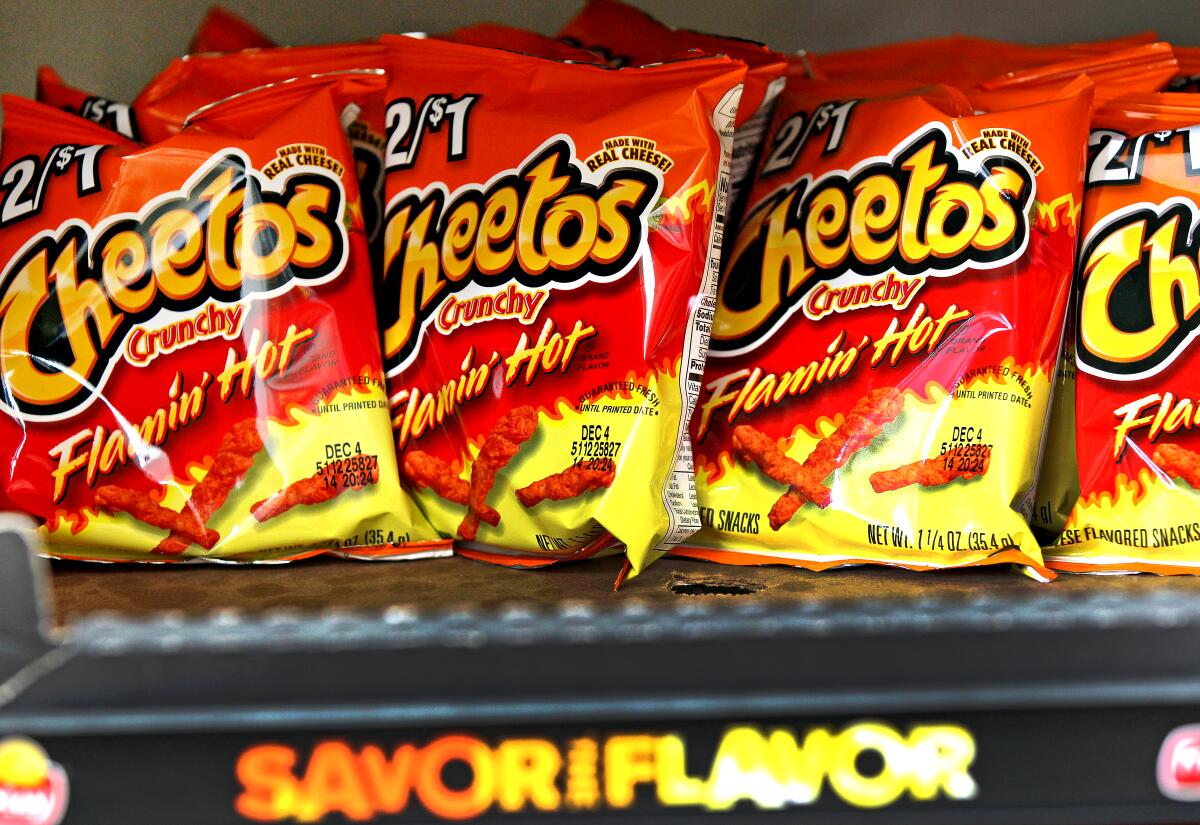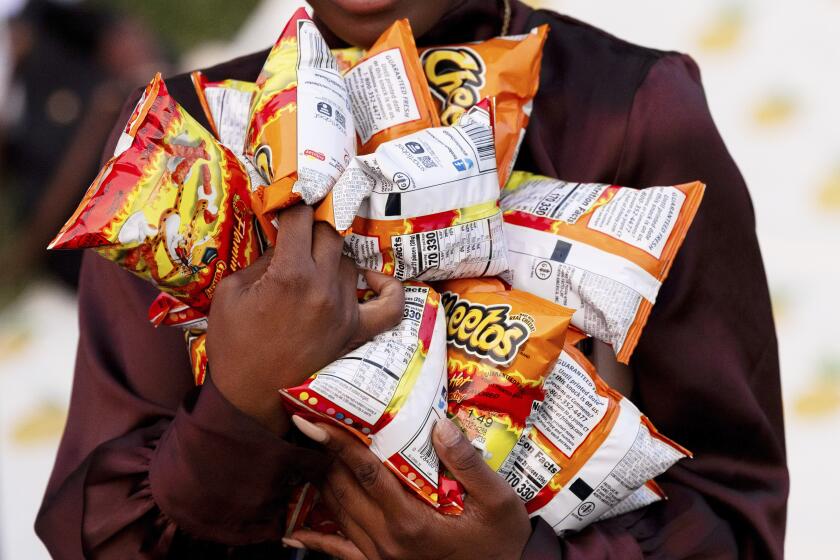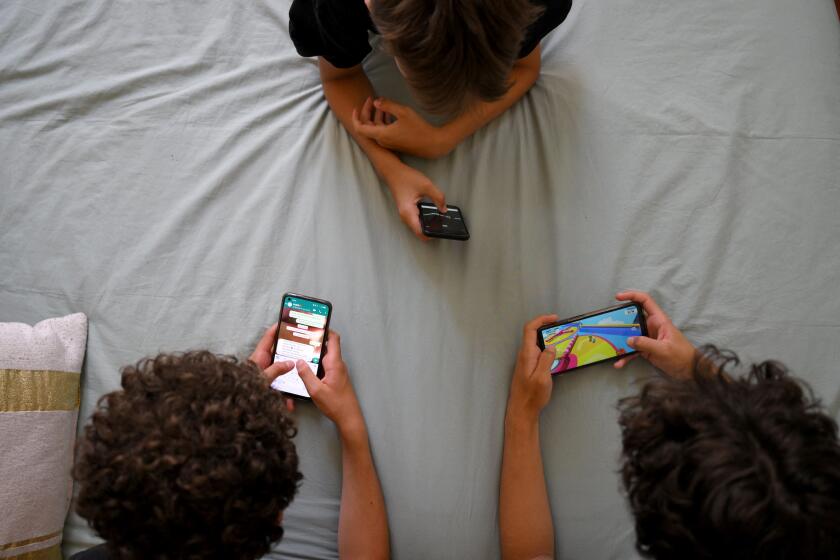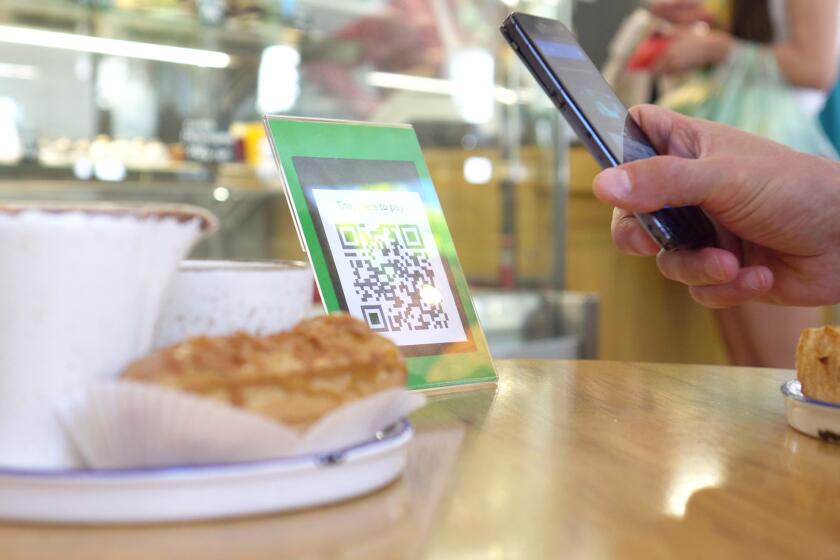Column: Flamin’ Hot Cheetos and iPhones are ruining my kid and yours

- Share via
With apologies to Allen Ginsberg:
I am seeing the best minds of our middle-school generation destroyed by Flamin’ Hot Cheetos and iPhones,
Teenagers on the cusp of young adulthood dragging themselves out of bed each day to mainline TikTok and Snapchat,
Measuring themselves by the yardstick of uber-filtered Kardashian perfection and falling short,
Getting expelled from school for sending AI-generated naked photos of classmates.
I want to howl about what’s happening to our kids. Between the negative brain effects of ultra-processed foods, and what can only be described as smartphone use disorder, something has gone terribly awry.
As it happens, you’ve caught me at a bad moment. In our home lately, the 13-year-old and I seem to be having daily conflicts over food and phones.
When she moved in with me at age 8, she had a smartphone, which I immediately put away. Her preference for ultra-processed food was already well-established; she’d been raised on a diet heavy on fast food and Lunchables.
Proposed legislation aims to ban from public schools snacks and sodas that contain artificial dyes. The list includes Cheetos, Takis, Doritos and Froot Loops.
We very consciously waited until eighth grade to get her an iPhone, as recommended by many childhood experts, but I honestly don’t think we waited long enough. Her first, non-smart phone allowed her to take pictures, make calls and text, but had no internet functions. In my view, it was perfect. In hers, an embarrassment.
When her iPhone arrived at the beginning of this school year, everything changed. Although we made a contract outlining the rules, her phone was never out of sight. Even when it was supposed to be put away, surreptitious use continued — in the classroom and at the dinner table. It became an appendage.
Taking away the phone as a consequence of breaking the rules, a stipulation in our contract, resulted in meltdowns. How are young teenagers supposed to regulate their phone use when they haven’t yet figured out how to regulate their moods or relationships? Giving a kid a smartphone is like putting a bomb in their hands and hoping it never goes off.
The Beverly Hills Unified School District board approved stipulated expulsions Wednesday evening for five 8th-grade students at Beverly Vista Middle School.
I am worn down trying to monitor my niece’s phone behavior and making sure she consumes a diet that will not turn her into a diabetic teenager. (No, I am not fat shaming anyone! I am pointing out that there is a relationship between the quality of food we eat, what we drink and the state of our health.)
On Monday, I opened the Wall Street Journal to find a story with an illustration of a human brain made entirely of Cheetos. They should have added an image of what your kids’ hands look like after consuming a bag of them. Or your furniture.
“Ultra-processed foods may not only affect our bodies,” the story began, “but our brains too. New research suggests links between ultra-processed foods — such as chips, many cereals and most packaged snacks at the grocery store — and changes in the way we learn, remember and feel.”
Because the foods mimic other addictive substances, the story said, “some scientists are proposing a new mental-health condition called ‘ultra-processed food disorder.’ ”
The older children are when they get their first smartphone, the better their mental health later in life. That’s little consolation to teens feeling left out when all their friends are connected.
And so I give thanks to California lawmakers for being willing to consider a bill that would ban from public schools foods that contain artificial dyes that have been linked to brain changes.
No one is suggesting that all these foods should be banned for everyone, all the time; only that, like sugary sodas, they should not be on offer or for sale at school during school hours.
Each weekday morning, I drop off my niece at school and watch as nearly every kid shuffles along, head down, eyes focused not on the world around them, but on their smartphones. They cross the street looking at their smartphones. They stand in clumps looking at their smartphones. When I pick her up in the afternoon, same thing.
Last week in the Atlantic, Jonathan Haidt, a social psychologist at New York University’s Stern School of Business proposed that smartphones have changed the very nature of childhood — and not for the better.
The right-wing hysteria over books with sexual, violent or racial themes is ridiculous. Not that the left, even in California, is entirely innocent
“What is childhood — including adolescence — and how did it change when smartphones moved to the center of it?” Haidt asks. “If we take a more holistic view of what childhood is and what young children, tweens, and teens need to do to mature into competent adults, the picture becomes much clearer. Smartphone-based life, it turns out, alters or interferes with a great number of developmental processes.”
Among them, he writes, kids spend less time playing with each other, less time taking physical risks (like climbing trees!), less time interacting face to face, less time learning from real-time conversational cues and less time learning how to resolve conflict (why do that when you can just block your antagonist?).
He suggests that the psychological development of children born in and after 1996 has been “fundamentally altered” by the ubiquity of smartphones.
With links between mental health challenges and excessive technology use, our app-dependent world should make it easier for a flip phone user like me.
“Synchronous interactions make us feel closer to the other person because that’s what getting ‘in sync’ does,” he writes. “Texts, posts, and many other virtual interactions lack synchrony. There is less real laughter, more room for misinterpretation, and more stress after a comment that gets no immediate response.”
Add to that the insecurities inherent in an adolescent’s budding sexuality, or the indescribably mean way middle-school girls can behave with one another, plus the availability of online porn and you have a social nightmare on your hands.
“My claim,” writes Haidt, “is that the new phone-based childhood that took shape roughly 12 years ago is making young people sick and blocking their progress to flourishing in adulthood. We need a dramatic cultural correction, and we need it now.”
He proposes four simple correctives that wouldn’t cost a penny: No smartphones before high school. No social media before 16. Phone-free schools. More independence, free play and responsibility in the real world.
How I wish it were as easy as writing down such commonsense rules, or even passing a law.
More to Read
A cure for the common opinion
Get thought-provoking perspectives with our weekly newsletter.
You may occasionally receive promotional content from the Los Angeles Times.

















